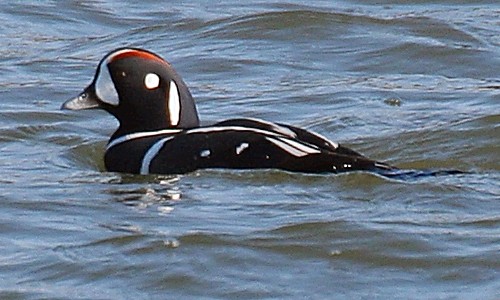Harlequin Duck
A species of Harlequin Ducks, Also known as Lords And Ladies, Totem Pole Duck, Glacier Duck, Blue Streak, Squeaker Scientific name : Histrionicus histrionicus Genus : Harlequin Ducks
Harlequin Duck, A species of Harlequin Ducks
Also known as:
Lords And Ladies, Totem Pole Duck, Glacier Duck, Blue Streak, Squeaker
Botanical name: Histrionicus histrionicus
Genus: Harlequin Ducks
Content
Description People often ask General Info
 Photo By Maga-chan , used under CC-BY-SA-2.5 /Cropped and compressed from original
Photo By Maga-chan , used under CC-BY-SA-2.5 /Cropped and compressed from original Description
Adult breeding males have a colorful and complex plumage pattern. The head and neck are dark slate blue with a large white crescent marking in front of the eye, a small round dot behind the eye, and a larger oval spot down the side of the neck. A black crown stripe runs over the top of the head, with chestnut patches on either side. A black-bordered white collar separates the head from the breast. The body is largely a lighter slate blue with chestnut sides. A black-bordered white bar divides the breast vertically from the sides. The tail is black, long and pointed. The speculum is metallic blue. The inner secondary feathers are white and form white markings over the back when folded. The bill is blue-grey and the eye is reddish. Adult females are less colourful, with brownish-grey plumage with three white patches on the head: a round spot behind the eye, a larger patch from the eye to the bill and a small spot above the eye. 
Size
38-53 cm (15-21 in)
Life Expectancy
12-15 years
Nest Placement
Ground
Clutch Size
4 - 8 eggs
Incubation Period
1 brood
Number of Broods
27 - 29 days
Feeding Habits
Harlequin Duck's diet consists of aquatic invertebrates and small fish. Prefer mollusks, crustaceans, and insects. During breeding, they consume midges and fish eggs, whereas tidal marine invertebrates like crabs, amphipods, barnacles, mussels, limpets, and snails are preferred in winter.
Habitat
Harlequin Duck inhabits fast-flowing rivers, streams in subalpine and coastal areas, preferring rocky terrains. They breed in turbulent waters, often near lake outlets, and relax on calmer river sections, islands, and sandbars post-hatching. Winter habitats include rocky coastal shorelines with eelgrass and kelp beds, headlands, and cobble beaches, using boulders and open waters for nightly roosts.
Nest Behavior
Harlequin Duck's nesting period starts with the selection of a secluded site by the female, followed by egg-laying. Parental care is the responsibility of the female who incubates the eggs and tends to the ducklings post-hatching.
Nest Characteristics
Harlequin Duck typically chooses nesting sites on cliff ledges, in tree cavities, or occasionally on the ground. Nests are composed of conifer needles, mosses, leaf litter, or small stones and are lined with soft down feathers from the female.
Dite type
Aquatic invertebrate eater
People often ask
General Info
Feeding Habits
Bird food type
Behavior
Harlequin Duck exhibit remarkable adaptation to turbulent riverine and coastal environments where they perform their daily activities. Their adept swimming capabilities enable them to navigate swift currents while executing proficient dives to forage, sometimes reaching depths of 70 feet. Uniquely, harlequin Duck display enduring monogamous relationships, reinforcing their bonds with synchronized winter displays and rushing behaviors aimed at potential threats. Nesting is a meticulous process, with females carefully selecting sites and solely undertaking incubation duties. Their young are immediately self-sufficient in foraging, though diving proficiency matures over weeks. Post-breeding, harlequin Duck demonstrate a social nature, congregating in large flocks and male 'clubs', thereby fostering communal interactions within nutrient-rich areas.
Distribution Area
Their breeding habitat is cold fast moving streams in north-western and north-eastern North America, Greenland, Iceland and eastern Russia. The nest is usually located in a well-concealed location on the ground near a stream. They are usually found near pounding surf and white water. They are short distance migrants and most winter near rocky shorelines on the Atlantic and Pacific coasts. They are very rare migrants to western Europe. The eastern North American population is declining and is considered endangered. Possible causes include loss of habitat due to hydroelectric projects and loss of life due to oil spills near coastal areas. 
Species Status
Not globally threatened.
Scientific Classification
Phylum
Chordates Class
Birds Order
Waterfowl Family
Geese Genus
Harlequin Ducks Species
Harlequin Duck